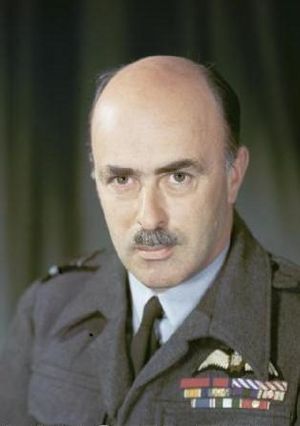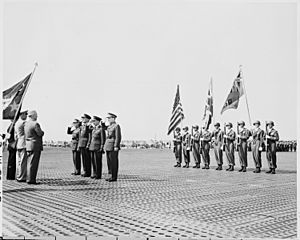James Robb (RAF officer) facts for kids
Quick facts for kids
Sir James Milne Robb
|
|
|---|---|

Air Vice Marshal James Robb
|
|
| Born | 26 January 1895 Hexham, Northumberland |
| Died | 18 December 1968 (aged 73) Bognor Regis, Sussex |
| Allegiance | United Kingdom |
| Service/ |
British Army (1914–18) Royal Air Force (1918–51) |
| Years of service | 1914–51 |
| Rank | Air Chief Marshal |
| Commands held | Inspector-General of the RAF (1951) RAF Fighter Command (1945–47) No. 15 Group RAF (1941–42) No. 2 Group RAF (1940–41) Central Flying School (1936–40) No. 3 Squadron RAF (1926–27) No. 30 Squadron RAF (1924–26) |
| Battles/wars | First World War: |
| Awards | Knight Grand Cross of the Order of the Bath Knight Commander of the Order of the British Empire Distinguished Service Order Distinguished Flying Cross Air Force Cross Mentioned in Despatches (3) Distinguished Service Medal (United States) Officer of the Legion of Merit (United States) Commander of the Legion of Honour (France) Grand Cross of the Order of the White Lion (Czechoslovakia) War Cross 1939–1945 (Czechoslovakia) |
Air Chief Marshal Sir James Milne Robb (26 January 1895 – 18 December 1968) was a very important leader in the Royal Air Force (RAF). He started his military career in the First World War with the Northumberland Fusiliers. Later, he joined the Royal Flying Corps and became a skilled pilot, shooting down seven enemy planes.
After the war, he joined the Royal Air Force permanently in 1919. He led No. 30 Squadron RAF during military actions in Iraq. In 1939, Robb went to Canada to help set up the Empire Air Training Scheme. This huge program trained many aircrew for the RAF from countries like Canada, Australia, and New Zealand during the Second World War. He also commanded No. 2 Group RAF and No. 15 Group RAF.
During the Second World War, Robb worked closely with Lieutenant General Dwight Eisenhower, who later became President of the United States. Robb was Eisenhower's air advisor during Operation Torch and later became Deputy Commander of the Northwest African Air Forces. When Eisenhower became the top Allied commander in Europe, he brought Robb to his headquarters as a key air staff member. In 1945, Robb became the head of RAF Fighter Command and even learned to fly the Gloster Meteor, which was the RAF's first jet aircraft. He retired in 1951 as an Air Chief Marshal.
Contents
Early Life and Education
James Milne Robb was born in Hexham, Northumberland, England, on 26 January 1895. He was the third son of James Thomas Robb, who was a fabric merchant. James went to George Watson's School in Edinburgh, Scotland, and then studied at Durham University. His older brother, William, also became a high-ranking officer in the British Army.
First World War Service
When the First World War began, Robb joined the 4th Battalion of the Northumberland Fusiliers. He became an officer, a second lieutenant, on 10 November 1914. A year later, he was promoted to captain. In August 1916, he moved to the Royal Flying Corps, which was the air force at the time.
After learning to fly, Robb joined No. 32 Squadron RFC. This was a fighter squadron on the Western Front, flying Airco DH.2 planes. He was injured in March 1917. After recovering, he returned to the Western Front in May 1918 as a flight commander with No. 92 Squadron RFC, flying SE5a planes. On 22 July, Robb achieved his squadron's first air victory by shooting down a German Fokker D.VII plane. For his bravery, he received the Distinguished Flying Cross in February 1919.
Between the World Wars
In August 1919, Robb was given a permanent position in the newly formed Royal Air Force (RAF) as a captain. He joined No. 24 Squadron RAF in February 1920. In September 1922, he was sent to Iraq to join No. 6 Squadron RAF, where he flew Bristol F.2 Fighter planes.
He was promoted to squadron leader in 1924 and took command of No. 30 Squadron RAF. Robb received the Distinguished Service Order for his service during military operations in Kurdistan in 1925.
After returning to the United Kingdom in 1926, Robb became the chief flying instructor at the Central Flying School at RAF Upavon. He married Bessie Murray on 29 December 1927, and they had a son and a daughter. In 1932, he was promoted to wing commander and attended the Royal Naval Staff College in Greenwich, London. He then served as a senior air officer on the aircraft carrier Eagle in the Far East. In 1935, he worked with the Mediterranean Fleet before returning to the Central Flying School as its leader. He was promoted to group captain in 1936.
Second World War Contributions

In 1939, Robb traveled to Canada to help create the Empire Air Training Scheme. This was a huge program that trained thousands of aircrew from Canada, Australia, New Zealand, and Southern Rhodesia for the Royal Air Force throughout the Second World War. In January 1940, he was promoted to air commodore. In April, he took command of No. 2 Group RAF. He received the Air Force Cross in July 1940 and was promoted again to air vice marshal in September. He was also honored as a Companion of the Order of the Bath in January 1941. Later, Robb was transferred to RAF Coastal Command, where he commanded No. 15 Group RAF.
In 1942, Robb became Deputy Chief of Combined Operations under Lord Louis Mountbatten. During Operation Torch, the Allied invasion of North Africa, he was the air advisor to the top commander, Lieutenant General Dwight Eisenhower. In February 1943, Eisenhower appointed him Deputy Commander of the Northwest African Air Forces. When Eisenhower became the Supreme Allied Commander in Europe in January 1944, he brought Robb to his Supreme Headquarters Allied Expeditionary Force as Deputy Chief of Staff (Air). Robb was promoted to air marshal in October 1944 and was made a Knight Commander of the Order of the British Empire in January 1945.
In May 1945, he was appointed the head of RAF Fighter Command. He even learned to fly the Gloster Meteor, which was the RAF's very first operational jet aircraft. He claimed to have flown over 150 different types of aircraft in his career! In August 1945, he received the U.S. Distinguished Service Medal from the President of the United States, Harry S. Truman.
After the War
In 1947, Robb became Vice-Chief of the Air Staff, a very senior position in the RAF. He then became the Commander in Chief of the air forces for the Western Union Defence Organisation in 1948. Finally, in 1951, he became the Inspector General of the RAF. He received further high honors, becoming a Knight Commander of the Order of the Bath in June 1949 and a Knight Grand Cross of the Order of the Bath in January 1951.
After retiring from the RAF due to health reasons, he took on a ceremonial role as King of Arms of the Order of the Bath from 1952 to 1965.
Robb also helped write a volume of the official history of the Second World War, called Victory in the West (1962).
He passed away at a nursing home in Bognor Regis, Sussex, on 18 December 1968.
Images for kids


